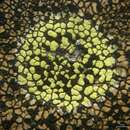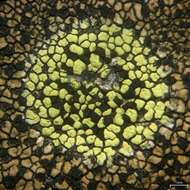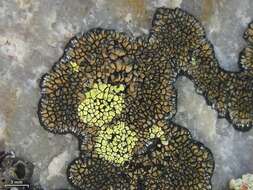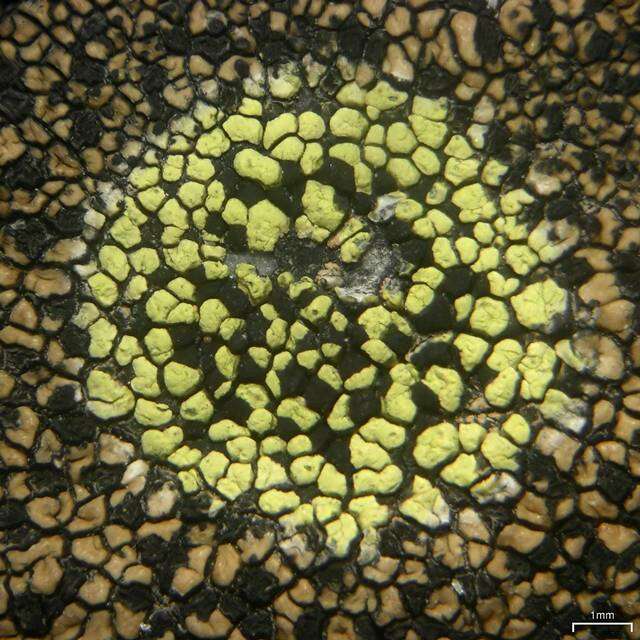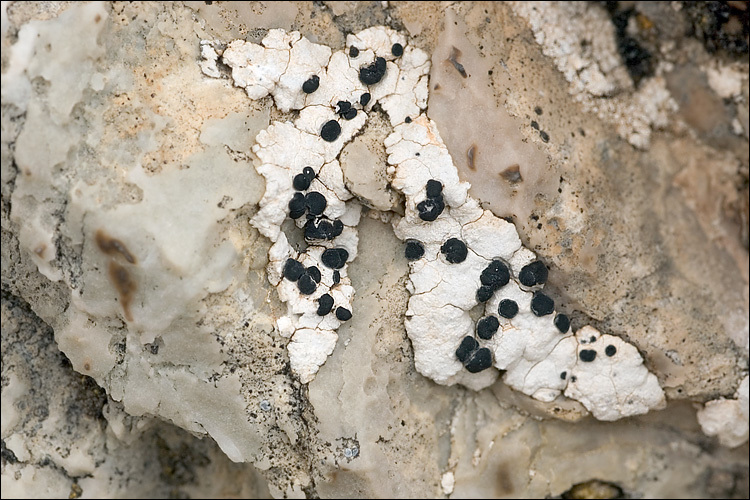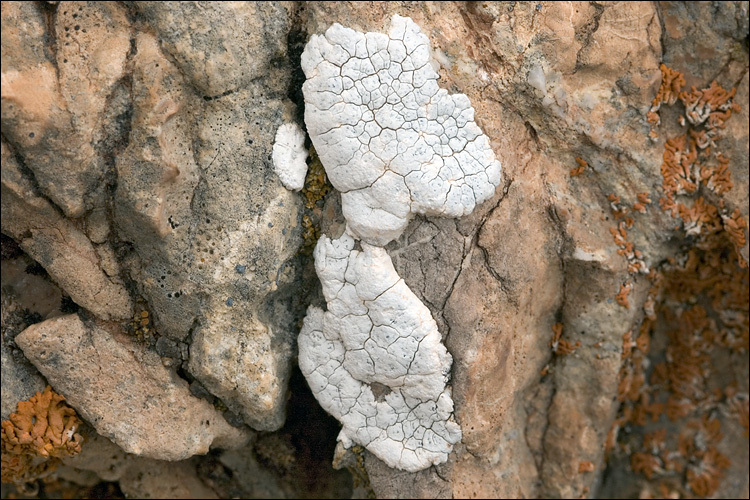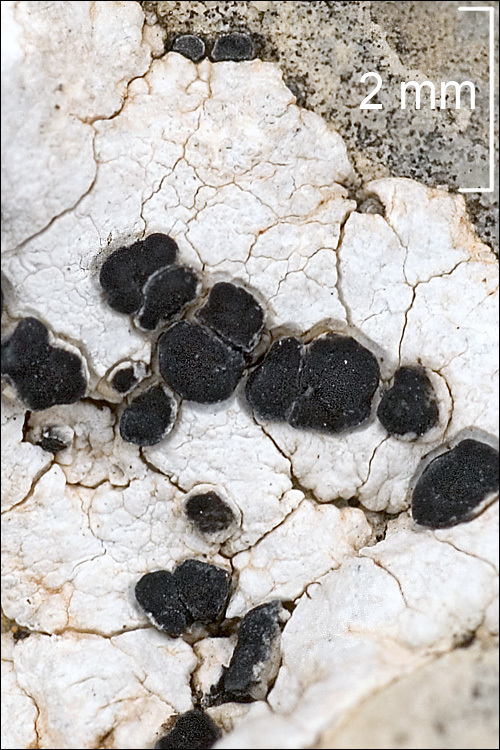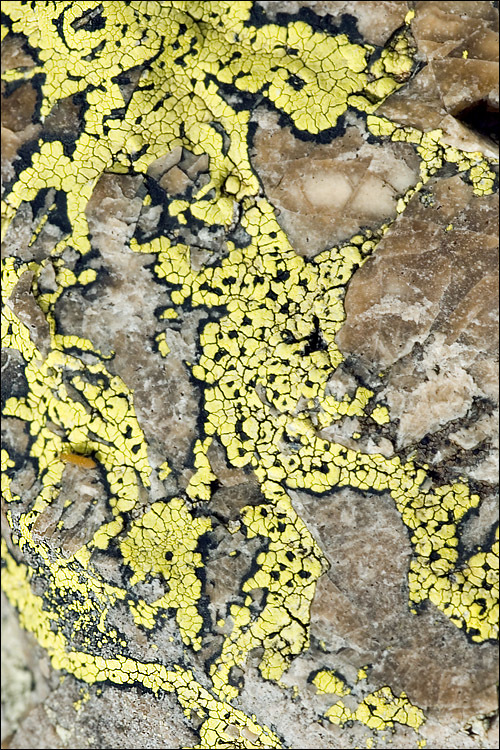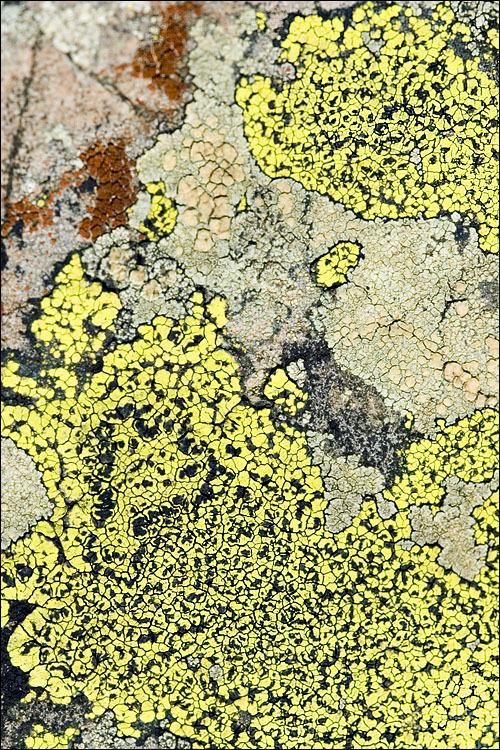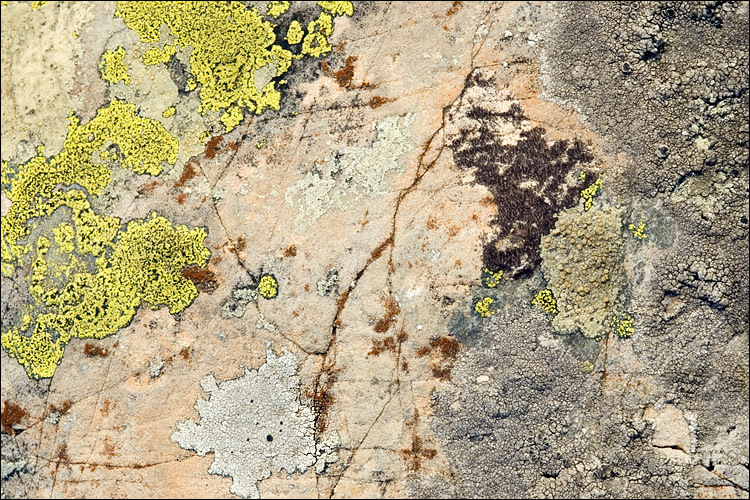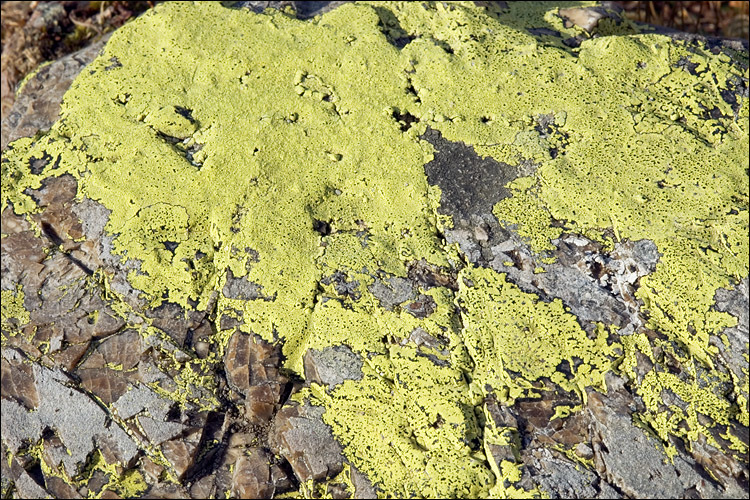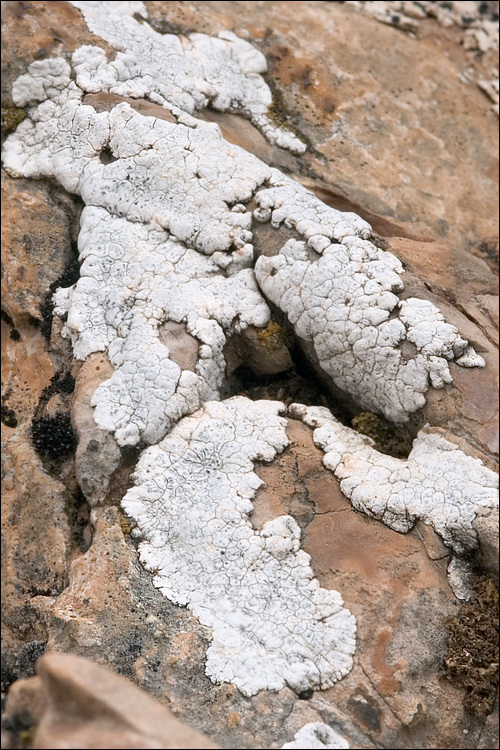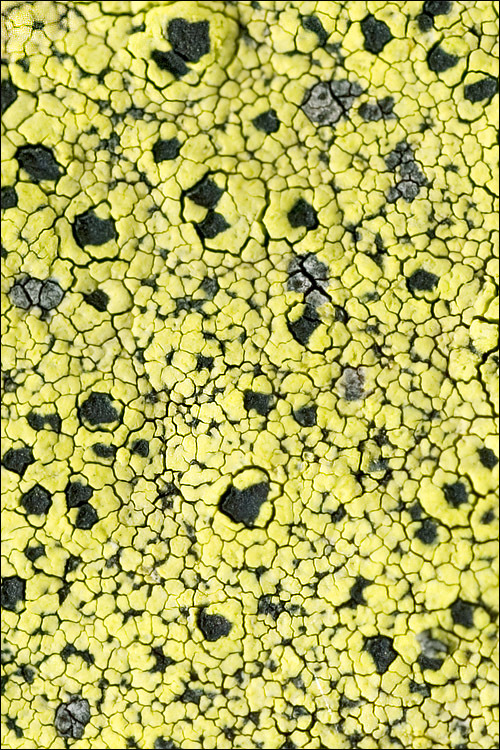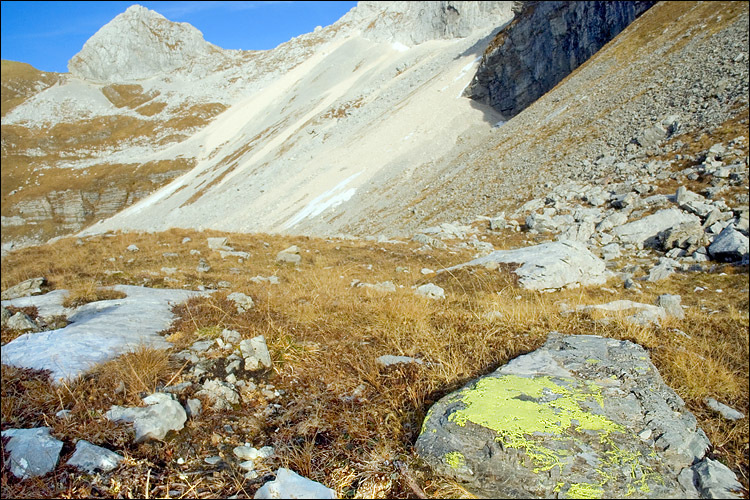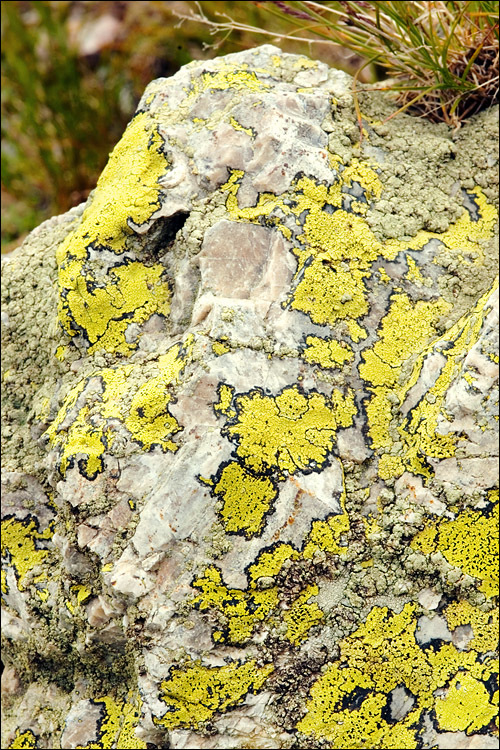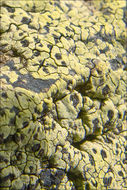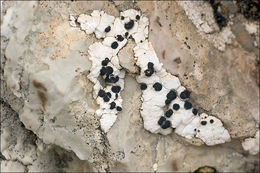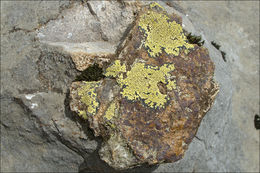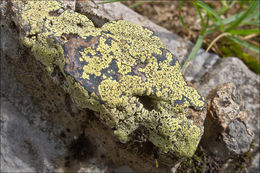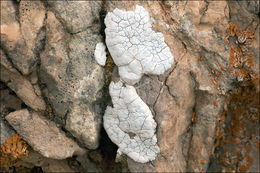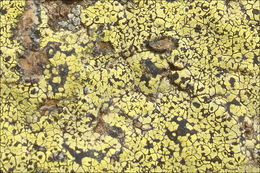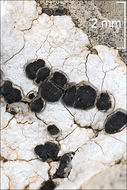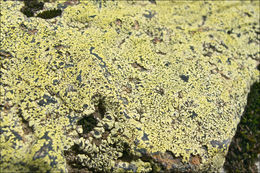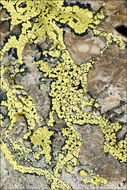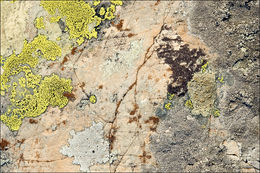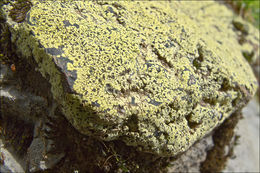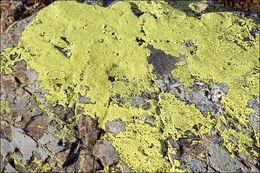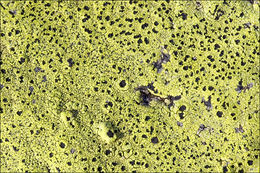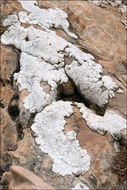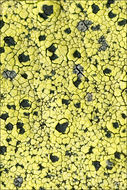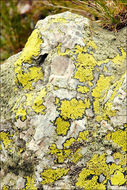-
Mushroom Observer Image 502462: Rhizocarpon pusillum Runem.
-
Mushroom Observer Image 502463: Rhizocarpon pusillum Runem.
-
Mushroom Observer Image 502464: Rhizocarpon pusillum Runem. & Sporastatia testudinea (Ach.) A. Massal.
-
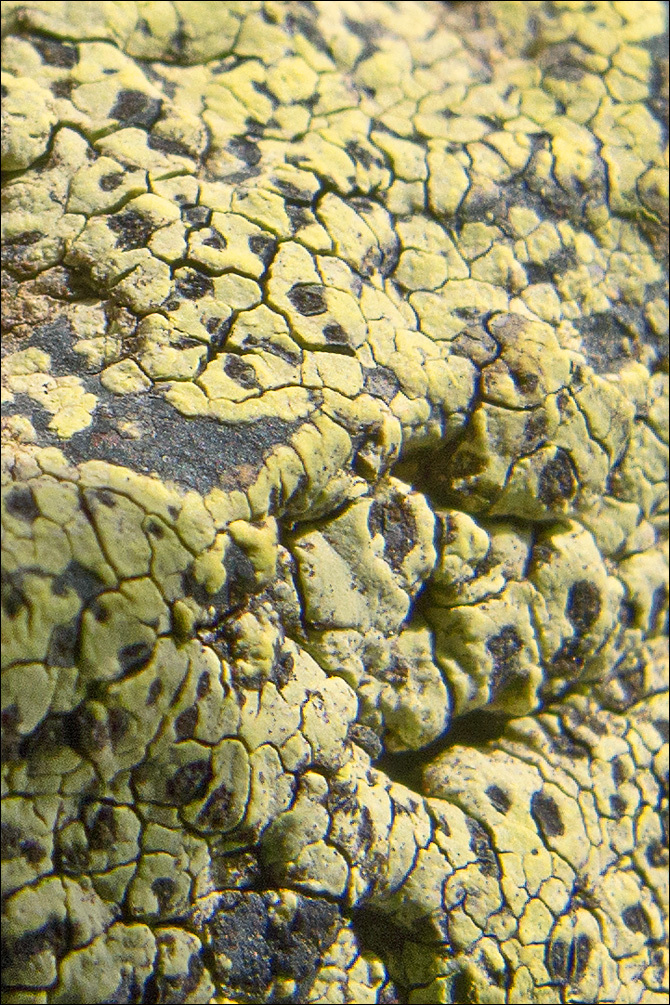
Slo.: zemljevidni skorjevec - syn.: Rhizocarpon riparium Rs - Habitat: mountain grassland, moderately steep mountain slope, south aspect; on the border of limestone and flysh bedrock; open place, full sun, moist place; exposed to direct rain; elevation 1.400 m (4.600 feet); average precipitations ~ 3.000 mm/year, average temperature 3-5 deg C, pre-alpine phytogeographical region. Substratum: small inclusions of hard, smooth, siliceous rock in bare, exposed calcareous (limestone or dolomite) bedrock. Comment: Rhizocarpon geographicum is beautiful, conspicuous lichen, which is very common in the regions with siliceous, acid ground. But in Slovenia it is rather a rare find because of the lack of such ground. With its bright yellow thallus, black apothecia and black prothallus and characteristically areolate pattern of the thallus, which coarsely resembles a map, it is superficially easy to determine. However the Rhizocarpon geographicum group is extremely polymorphic, still poorly understood species complex. Several taxa have been separated with slightly different chemistry, spore properties and/or habit. The thallus of Rhizocarpon geographicum grows very slowly, only about 0.1 mm per year (Ref.4). The largest thalli can be much more than thousand years old. This slow hrouth is used in global warming studies. Retreat of glaciers can be measured by measuring thalli diameter along valleys with retreating glaciers.Thalli up to 10 x 6 cm large.Ref.:(1) F.S. Dobson, Lichens, The Richmonds Publishing Ca.LTD (2005), p 386.(2) V. Wirth, Die Flechten Baden-Wrttembergs, Teil.2., Ulmer (1995), p 812.(3) V. Wirth, R. Duell, Farbatlas Flechten und Moose, Ulmer, (2000), p 137.(4) B. Marbach, C. Kainz, Moose, Farne und Flechten, BLV Naturfrer (2002), p 90.(5) C.W.Smith, et all, The lichens of Great Britain and Ireland, The British Lichen Society, (2009), p 800.(6) I.M. Brodo, S.D. Sharnoff, S. Sharnoff, Lichens of North America, Yale Uni. Press (2001), p 635.
-
Habitat: Alpine grassland, fully exposed to sun, partly protected by direct rain, precipitations ~3.000 mm/year, average temperature 0-2 deg C, elevation 2.100 m (6.600 feet), alpine phytogeographical region. Substratum: south oriented vertical calcareous bedrock face. Ref.: F. Dobson, Lichens, The Richmond Publ. (2005), p390. V.Wirth, Die Flechten Baden-Wuerttembergs, Ulmer (1995), Vol.2., p819. Brodo, Sharnoff, Sharnoff, Lichens of North America, Yale Uni. Press (2001), p634. Determination not certain, although field characters fit well to literature.
-
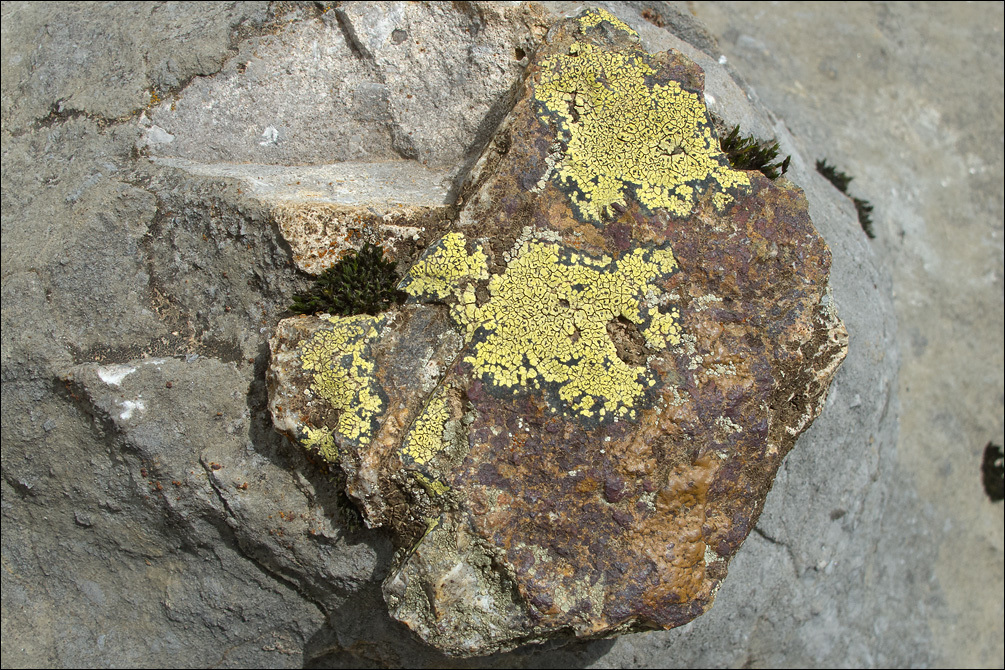
Slo.: zemljevidni skorjevec - syn.: Rhizocarpon riparium Rs - Habitat: mountain grassland, moderately steep mountain slope, south aspect; on the border of limestone and flysh bedrock; open place, full sun, moist place; exposed to direct rain; elevation 1.400 m (4.600 feet); average precipitations ~ 3.000 mm/year, average temperature 3-5 deg C, pre-alpine phytogeographical region. Substratum: small inclusions of hard, smooth, siliceous rock in bare, exposed calcareous (limestone or dolomite) bedrock. Comment: Rhizocarpon geographicum is beautiful, conspicuous lichen, which is very common in the regions with siliceous, acid ground. But in Slovenia it is rather a rare find because of the lack of such ground. With its bright yellow thallus, black apothecia and black prothallus and characteristically areolate pattern of the thallus, which coarsely resembles a map, it is superficially easy to determine. However the Rhizocarpon geographicum group is extremely polymorphic, still poorly understood species complex. Several taxa have been separated with slightly different chemistry, spore properties and/or habit. The thallus of Rhizocarpon geographicum grows very slowly, only about 0.1 mm per year (Ref.4). The largest thalli can be much more than thousand years old. This slow hrouth is used in global warming studies. Retreat of glaciers can be measured by measuring thalli diameter along valleys with retreating glaciers. Thalli up to 10 x 6 cm large. Ref.: (1) F.S. Dobson, Lichens, The Richmonds Publishing Ca.LTD (2005), p 386. (2) V. Wirth, Die Flechten Baden-Wrttembergs, Teil.2., Ulmer (1995), p 812. (3) V. Wirth, R. Duell, Farbatlas Flechten und Moose, Ulmer, (2000), p 137. (4) B. Marbach, C. Kainz, Moose, Farne und Flechten, BLV Naturfrer (2002), p 90. (5) C.W.Smith, et all, The lichens of Great Britain and Ireland, The British Lichen Society, (2009), p 800. (6) I.M. Brodo, S.D. Sharnoff, S. Sharnoff, Lichens of North America, Yale Uni. Press (2001), p 635.
-
Habitat: Alpine grassland, fully exposed to sun, partly protected from direct rain, precipitations ~3.000 mm/year, average temperature 0-2 deg C, elevation 2.100 m (6.600 feet), alpine phytogeographical region. Substratum: south oriented vertical calcareous bedrock face. Ref.: F. Dobson, Lichens, The Richmond Publ. (2005), p390. V.Wirth, Die Flechten Baden-Wuerttembergs, Ulmer (1995), Vol.2., p819. Brodo, Sharnoff, Sharnoff, Lichens of North America, Yale Uni. Press (2001), p634. Determination not certain, although field characters fit well to literature.
-
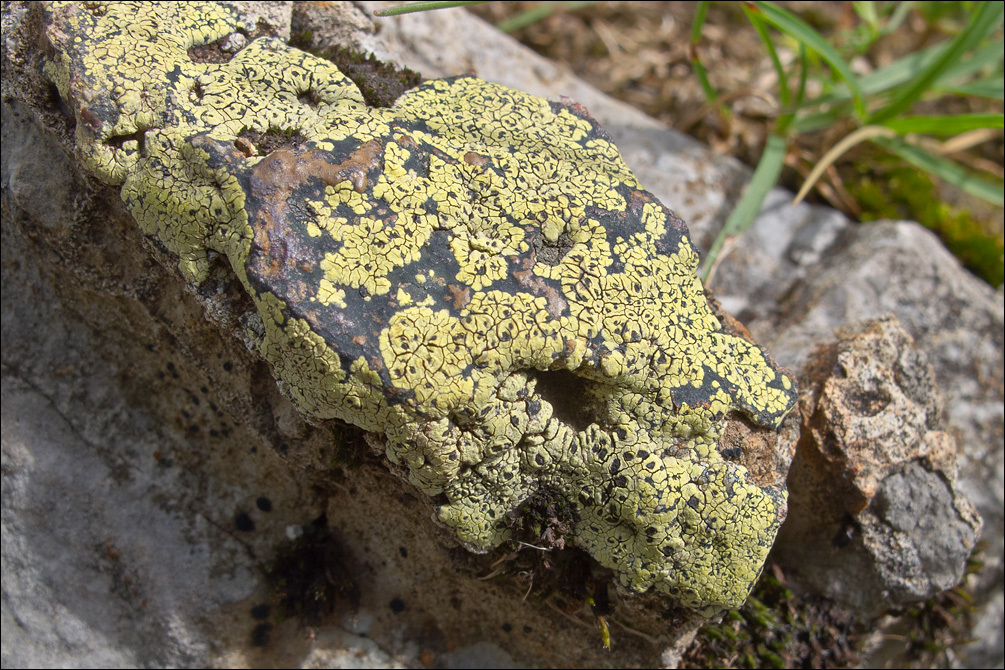
Slo.: zemljevidni skorjevec - syn.: Rhizocarpon riparium Rs - Habitat: mountain grassland, moderately steep mountain slope, south aspect; on the border of limestone and flysh bedrock; open place, full sun, moist place; exposed to direct rain; elevation 1.400 m (4.600 feet); average precipitations ~ 3.000 mm/year, average temperature 3-5 deg C, pre-alpine phytogeographical region. Substratum: small inclusions of hard, smooth, siliceous rock in bare, exposed calcareous (limestone or dolomite) bedrock. Comment: Rhizocarpon geographicum is beautiful, conspicuous lichen, which is very common in the regions with siliceous, acid ground. But in Slovenia it is rather a rare find because of the lack of such ground. With its bright yellow thallus, black apothecia and black prothallus and characteristically areolate pattern of the thallus, which coarsely resembles a map, it is superficially easy to determine. However the Rhizocarpon geographicum group is extremely polymorphic, still poorly understood species complex. Several taxa have been separated with slightly different chemistry, spore properties and/or habit. The thallus of Rhizocarpon geographicum grows very slowly, only about 0.1 mm per year (Ref.4). The largest thalli can be much more than thousand years old. This slow hrouth is used in global warming studies. Retreat of glaciers can be measured by measuring thalli diameter along valleys with retreating glaciers. Thalli up to 10 x 6 cm large. Ref.: (1) F.S. Dobson, Lichens, The Richmonds Publishing Ca.LTD (2005), p 386. (2) V. Wirth, Die Flechten Baden-Wrttembergs, Teil.2., Ulmer (1995), p 812. (3) V. Wirth, R. Duell, Farbatlas Flechten und Moose, Ulmer, (2000), p 137. (4) B. Marbach, C. Kainz, Moose, Farne und Flechten, BLV Naturfrer (2002), p 90. (5) C.W.Smith, et all, The lichens of Great Britain and Ireland, The British Lichen Society, (2009), p 800. (6) I.M. Brodo, S.D. Sharnoff, S. Sharnoff, Lichens of North America, Yale Uni. Press (2001), p 635.
-
Habitat: Alpine grassland, fully exposed to sun, partly protected from direct rain, precipitations ~3.000 mm/year, average temperature 0-2 deg C, elevation 2.100 m (6.600 feet), alpine phytogeographical region. Substratum: south oriented vertical calcareous bedrock face. Ref.: F. Dobson, Lichens, The Richmond Publ. (2005), p390. V.Wirth, Die Flechten Baden-Wuerttembergs, Ulmer (1995), Vol.2., p819. Brodo, Sharnoff, Sharnoff, Lichens of North America, Yale Uni. Press (2001), p634. Determination not certain, although field characters fit well to literature.
-
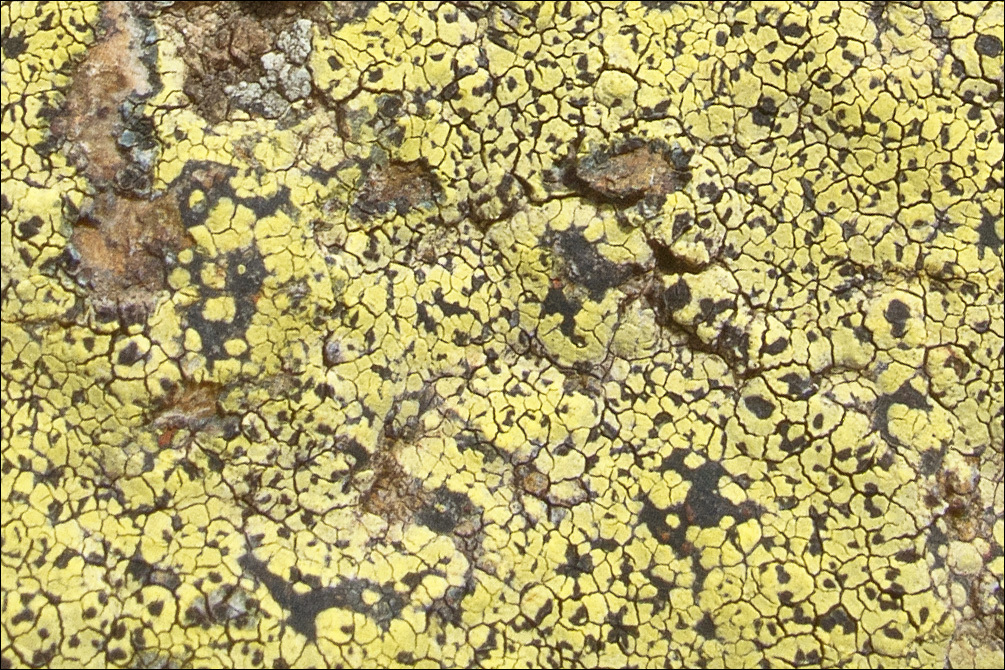
Slo.: zemljevidni skorjevec - syn.: Rhizocarpon riparium Rs - Habitat: mountain grassland, moderately steep mountain slope, south aspect; on the border of limestone and flysh bedrock; open place, full sun, moist place; exposed to direct rain; elevation 1.400 m (4.600 feet); average precipitations ~ 3.000 mm/year, average temperature 3-5 deg C, pre-alpine phytogeographical region. Substratum: small inclusions of hard, smooth, siliceous rock in bare, exposed calcareous (limestone or dolomite) bedrock. Comment: Rhizocarpon geographicum is beautiful, conspicuous lichen, which is very common in the regions with siliceous, acid ground. But in Slovenia it is rather a rare find because of the lack of such ground. With its bright yellow thallus, black apothecia and black prothallus and characteristically areolate pattern of the thallus, which coarsely resembles a map, it is superficially easy to determine. However the Rhizocarpon geographicum group is extremely polymorphic, still poorly understood species complex. Several taxa have been separated with slightly different chemistry, spore properties and/or habit. The thallus of Rhizocarpon geographicum grows very slowly, only about 0.1 mm per year (Ref.4). The largest thalli can be much more than thousand years old. This slow hrouth is used in global warming studies. Retreat of glaciers can be measured by measuring thalli diameter along valleys with retreating glaciers. Thalli up to 10 x 6 cm large. Ref.: (1) F.S. Dobson, Lichens, The Richmonds Publishing Ca.LTD (2005), p 386. (2) V. Wirth, Die Flechten Baden-Wrttembergs, Teil.2., Ulmer (1995), p 812. (3) V. Wirth, R. Duell, Farbatlas Flechten und Moose, Ulmer, (2000), p 137. (4) B. Marbach, C. Kainz, Moose, Farne und Flechten, BLV Naturfrer (2002), p 90. (5) C.W.Smith, et all, The lichens of Great Britain and Ireland, The British Lichen Society, (2009), p 800. (6) I.M. Brodo, S.D. Sharnoff, S. Sharnoff, Lichens of North America, Yale Uni. Press (2001), p 635.
-
Habitat: Alpine grassland, fully exposed to sun, partly protected from direct rain, precipitations ~3.000 mm/year, average temperature 0-2 deg C, elevation 2.100 m (6.600 feet), alpine phytogeographical region. Substratum: south oriented vertical calcareous bedrock face. Ref.: F. Dobson, Lichens, The Richmond Publ. (2005), p390. V.Wirth, Die Flechten Baden-Wuerttembergs, Ulmer (1995), Vol.2., p819. Brodo, Sharnoff, Sharnoff, Lichens of North America, Yale Uni. Press (2001), p634. Determination not certain, although field characters fit well to literature.
-
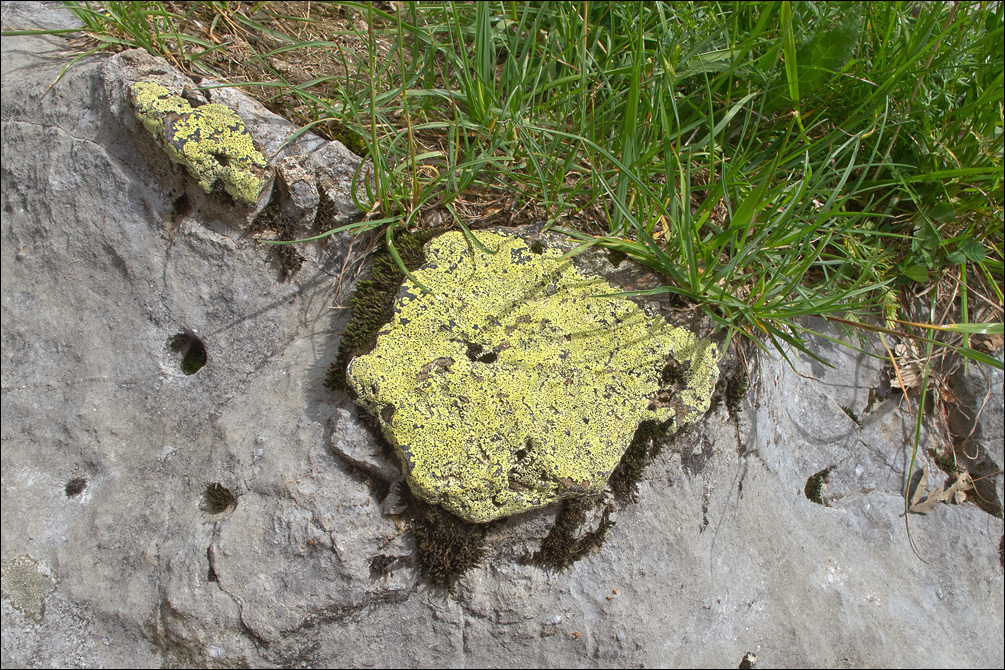
Slo.: zemljevidni skorjevec - syn.: Rhizocarpon riparium Rs - Habitat: mountain grassland, moderately steep mountain slope, south aspect; on the border of limestone and flysh bedrock; open place, full sun, moist place; exposed to direct rain; elevation 1.400 m (4.600 feet); average precipitations ~ 3.000 mm/year, average temperature 3-5 deg C, pre-alpine phytogeographical region. Substratum: small inclusions of hard, smooth, siliceous rock in bare, exposed calcareous (limestone or dolomite) bedrock. Comment: Rhizocarpon geographicum is beautiful, conspicuous lichen, which is very common in the regions with siliceous, acid ground. But in Slovenia it is rather a rare find because of the lack of such ground. With its bright yellow thallus, black apothecia and black prothallus and characteristically areolate pattern of the thallus, which coarsely resembles a map, it is superficially easy to determine. However the Rhizocarpon geographicum group is extremely polymorphic, still poorly understood species complex. Several taxa have been separated with slightly different chemistry, spore properties and/or habit. The thallus of Rhizocarpon geographicum grows very slowly, only about 0.1 mm per year (Ref.4). The largest thalli can be much more than thousand years old. This slow hrouth is used in global warming studies. Retreat of glaciers can be measured by measuring thalli diameter along valleys with retreating glaciers. Thalli up to 10 x 6 cm large. Ref.: (1) F.S. Dobson, Lichens, The Richmonds Publishing Ca.LTD (2005), p 386. (2) V. Wirth, Die Flechten Baden-Wrttembergs, Teil.2., Ulmer (1995), p 812. (3) V. Wirth, R. Duell, Farbatlas Flechten und Moose, Ulmer, (2000), p 137. (4) B. Marbach, C. Kainz, Moose, Farne und Flechten, BLV Naturfrer (2002), p 90. (5) C.W.Smith, et all, The lichens of Great Britain and Ireland, The British Lichen Society, (2009), p 800. (6) I.M. Brodo, S.D. Sharnoff, S. Sharnoff, Lichens of North America, Yale Uni. Press (2001), p 635.
-
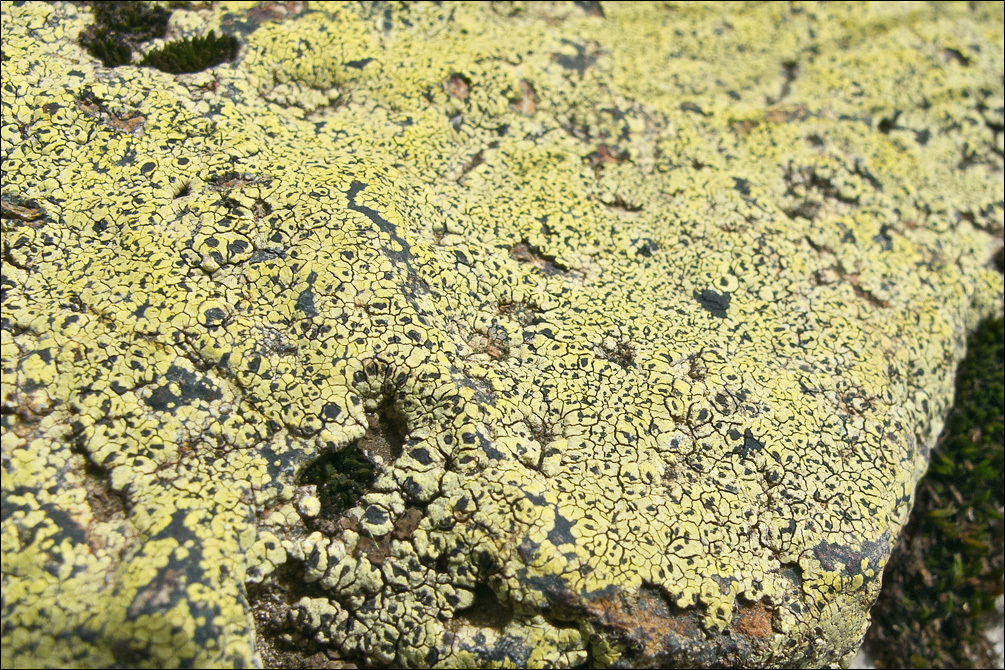
Slo.: zemljevidni skorjevec - syn.: Rhizocarpon riparium Rs - Habitat: mountain grassland, moderately steep mountain slope, south aspect; on the border of limestone and flysh bedrock; open place, full sun, moist place; exposed to direct rain; elevation 1.400 m (4.600 feet); average precipitations ~ 3.000 mm/year, average temperature 3-5 deg C, pre-alpine phytogeographical region. Substratum: small inclusions of hard, smooth, siliceous rock in bare, exposed calcareous (limestone or dolomite) bedrock. Comment: Rhizocarpon geographicum is beautiful, conspicuous lichen, which is very common in the regions with siliceous, acid ground. But in Slovenia it is rather a rare find because of the lack of such ground. With its bright yellow thallus, black apothecia and black prothallus and characteristically areolate pattern of the thallus, which coarsely resembles a map, it is superficially easy to determine. However the Rhizocarpon geographicum group is extremely polymorphic, still poorly understood species complex. Several taxa have been separated with slightly different chemistry, spore properties and/or habit. The thallus of Rhizocarpon geographicum grows very slowly, only about 0.1 mm per year (Ref.4). The largest thalli can be much more than thousand years old. This slow hrouth is used in global warming studies. Retreat of glaciers can be measured by measuring thalli diameter along valleys with retreating glaciers. Thalli up to 10 x 6 cm large. Ref.: (1) F.S. Dobson, Lichens, The Richmonds Publishing Ca.LTD (2005), p 386. (2) V. Wirth, Die Flechten Baden-Wrttembergs, Teil.2., Ulmer (1995), p 812. (3) V. Wirth, R. Duell, Farbatlas Flechten und Moose, Ulmer, (2000), p 137. (4) B. Marbach, C. Kainz, Moose, Farne und Flechten, BLV Naturfrer (2002), p 90. (5) C.W.Smith, et all, The lichens of Great Britain and Ireland, The British Lichen Society, (2009), p 800. (6) I.M. Brodo, S.D. Sharnoff, S. Sharnoff, Lichens of North America, Yale Uni. Press (2001), p 635.
-
Slo.: ? - Habitat: on a boulder laying in alpine grassland below scree slopes, full sun, precipitations > 3,000 mm/year fully exposed. - Substratum: rock surface, from vertical to horizontal orientation
-
Slo.: ? - Habitat: on a boulder laying in alpine grassland below scree slopes, full sun, precipitations > 3,000 mm/year fully exposed. - Substratum: rock surface, from vertical to horizontal orientation
-
Slo.: ? - Habitat: on a boulder laying in alpine grassland below scree slopes, full sun, precipitations > 3,000 mm/year fully exposed. - Substratum: rock surface, from vertical to horizontal orientation
-

Slo.: zemljevidni skorjevec - syn.: Rhizocarpon riparium Rs - Habitat: mountain grassland, moderately steep mountain slope, south aspect; on the border of limestone and flysh bedrock; open place, full sun, moist place; exposed to direct rain; elevation 1.400 m (4.600 feet); average precipitations ~ 3.000 mm/year, average temperature 3-5 deg C, pre-alpine phytogeographical region. Substratum: small inclusions of hard, smooth, siliceous rock in bare, exposed calcareous (limestone or dolomite) bedrock. Comment: Rhizocarpon geographicum is beautiful, conspicuous lichen, which is very common in the regions with siliceous, acid ground. But in Slovenia it is rather a rare find because of the lack of such ground. With its bright yellow thallus, black apothecia and black prothallus and characteristically areolate pattern of the thallus, which coarsely resembles a map, it is superficially easy to determine. However the Rhizocarpon geographicum group is extremely polymorphic, still poorly understood species complex. Several taxa have been separated with slightly different chemistry, spore properties and/or habit. The thallus of Rhizocarpon geographicum grows very slowly, only about 0.1 mm per year (Ref.4). The largest thalli can be much more than thousand years old. This slow hrouth is used in global warming studies. Retreat of glaciers can be measured by measuring thalli diameter along valleys with retreating glaciers. Thalli up to 10 x 6 cm large. Ref.: (1) F.S. Dobson, Lichens, The Richmonds Publishing Ca.LTD (2005), p 386. (2) V. Wirth, Die Flechten Baden-Wrttembergs, Teil.2., Ulmer (1995), p 812. (3) V. Wirth, R. Duell, Farbatlas Flechten und Moose, Ulmer, (2000), p 137. (4) B. Marbach, C. Kainz, Moose, Farne und Flechten, BLV Naturfrer (2002), p 90. (5) C.W.Smith, et all, The lichens of Great Britain and Ireland, The British Lichen Society, (2009), p 800. (6) I.M. Brodo, S.D. Sharnoff, S. Sharnoff, Lichens of North America, Yale Uni. Press (2001), p 635.
-
Slo.: ? - Habitat: on a boulder laying in alpine grassland below scree slopes, full sun, precipitations > 3,000 mm/year fully exposed. - Substratum: rock surface, from vertical to horizontal orientation
-
Slo.: ? - Habitat: on a boulder laying in alpine grassland below scree slopes, full sun, precipitations > 3,000 mm/year fully exposed. - Substratum: rock surface, from vertical to horizontal orientation
-
Habitat: Alpine grassland, fully exposed to sun, partly protected from direct rain, precipitations ~3.000 mm/year, average temperature 0-2 deg C, elevation 2.100 m (6.600 feet), alpine phytogeographical region. Substratum: south oriented vertical calcareous bedrock face. Ref.: F. Dobson, Lichens, The Richmond Publ. (2005), p390. V.Wirth, Die Flechten Baden-Wuerttembergs, Ulmer (1995), Vol.2., p819. Brodo, Sharnoff, Sharnoff, Lichens of North America, Yale Uni. Press (2001), p634. Determination not certain, although field characters fit well to literature.
-
Slo.: ? - Habitat: on a boulder laying in alpine grassland below scree slopes, full sun, precipitations > 3,000 mm/year fully exposed. - Substratum: rock surface, from vertical to horizontal orientation
-
Slo.: ? - Habitat: on a boulder laying in alpine grassland below scree slopes, full sun, precipitations > 3,000 mm/year fully exposed. - Substratum: rock surface, from vertical to horizontal orientation
-
Slo.: ? - Habitat: alpine grassland, full sun, precipitations > 3,000 mm/year fully exposed. Substratum: siliceous rock surface, almost vertical orientation
-
Slo.: ? - Habitat: alpine grassland, full sun, precipitations > 3,000 mm/year fully exposed. Substratum: siliceous rock surface, almost vertical orientation

